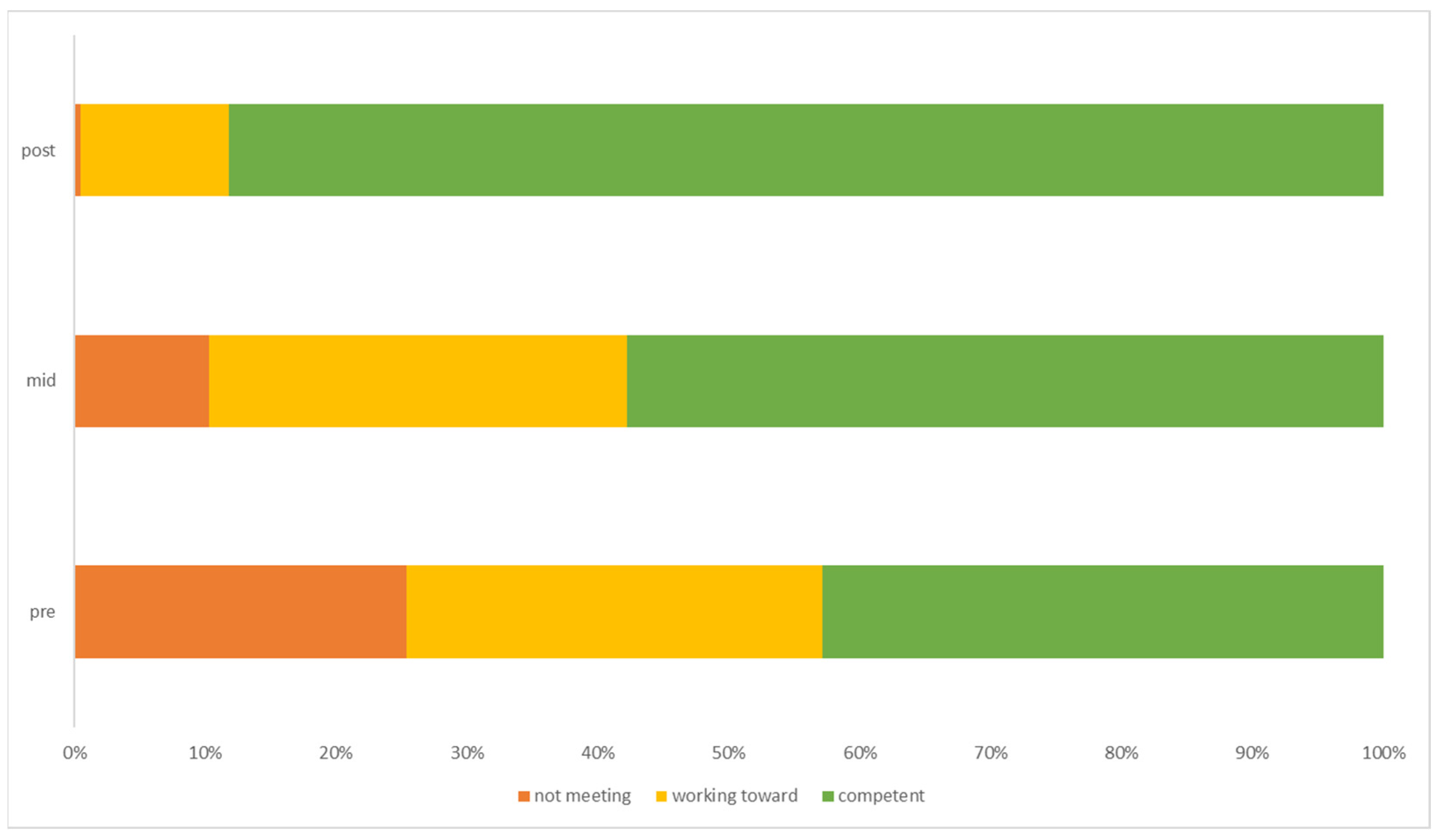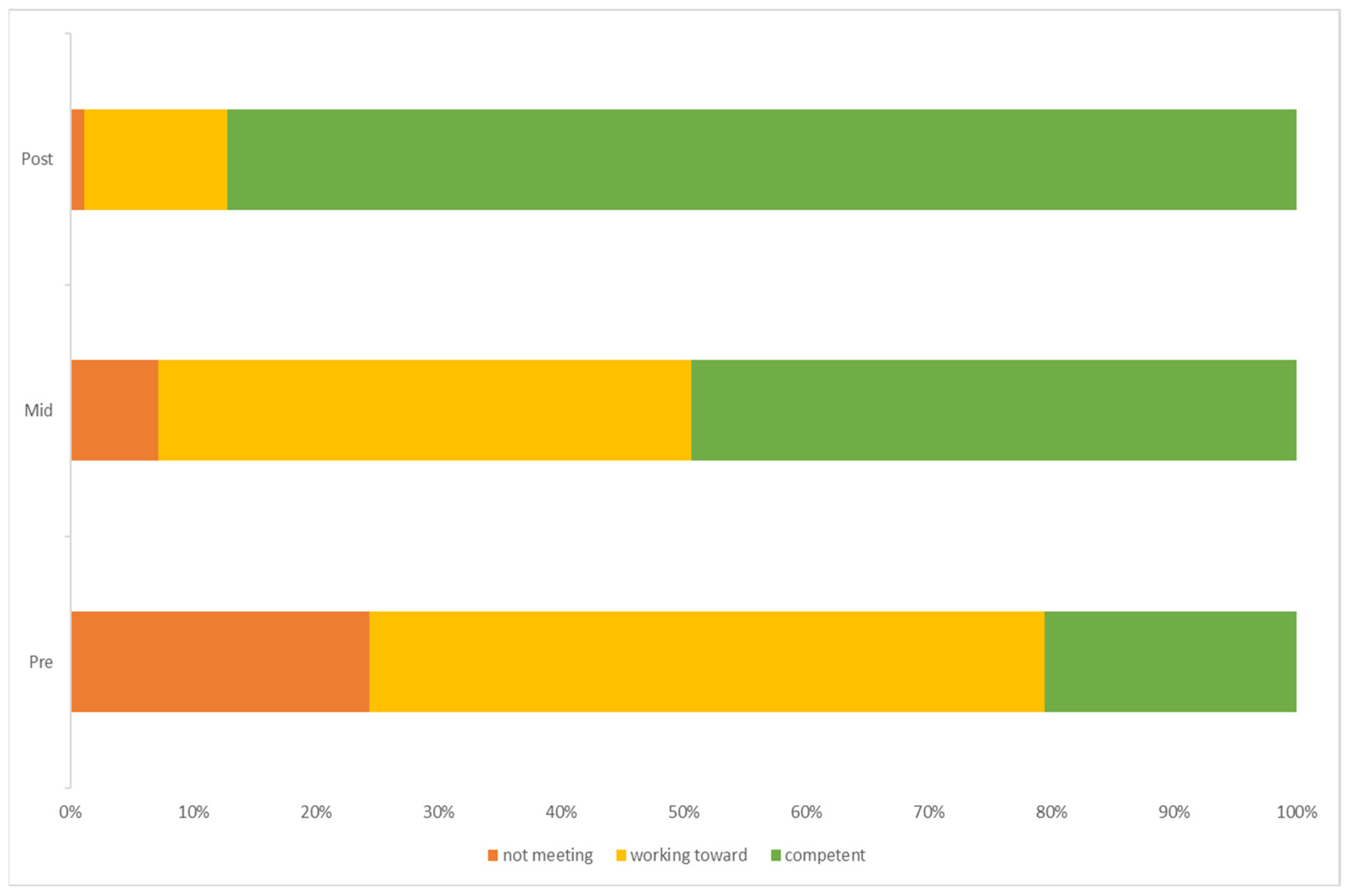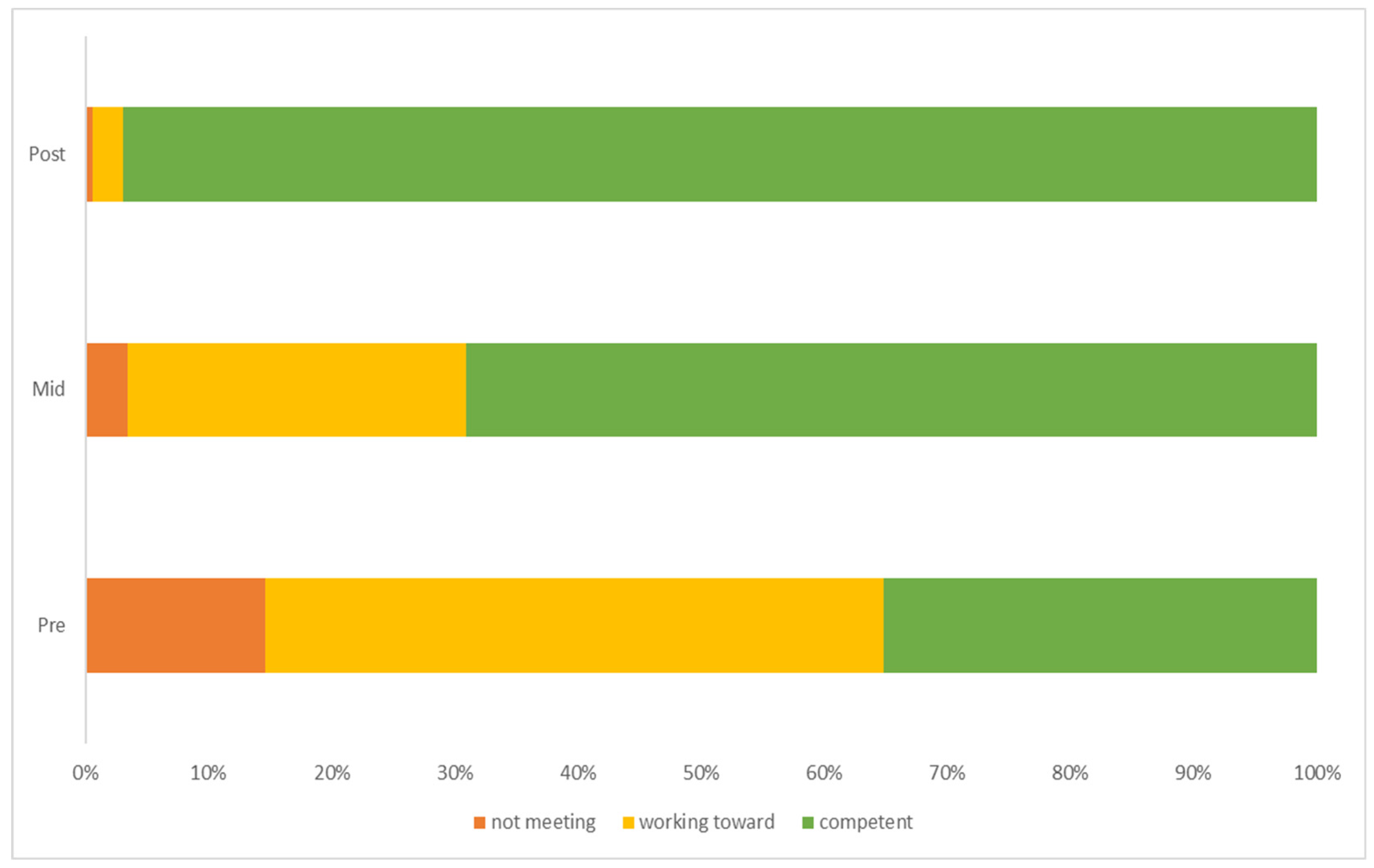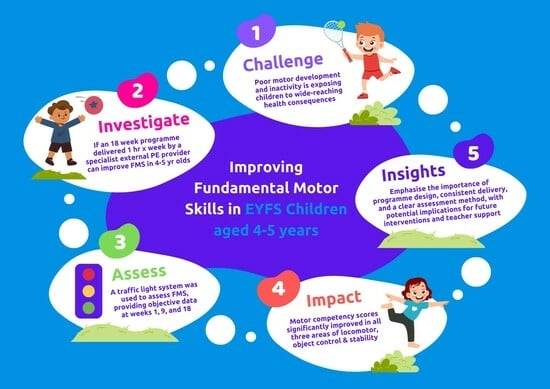Impact and Implementation of an Early Years Fundamental Motor Skills Intervention for Children 4–5 Years
Abstract
1. Introduction
2. Materials and Methods
2.1. Participants
2.2. Intervention Context
2.3. Methodological Context and Assessment of FMS
2.4. Statistical Analysis
3. Results
4. Discussion
4.1. Effectiveness of the Early Years FMS Intervention
4.2. The Implementation and Evaluation of the Early Years FMS Intervention
4.3. Limitations and Strengths of This Evaluation
5. Conclusions
Supplementary Materials
Author Contributions
Funding
Institutional Review Board Statement
Informed Consent Statement
Data Availability Statement
Acknowledgments
Conflicts of Interest
References
- Zeng, N.; Johnson, S.L.; Boles, R.E.; Bellows, L.L. Social-ecological correlates of fundamental movement skills in young children. J. Sport Health Sci. 2019, 8, 122–129. [Google Scholar] [CrossRef] [PubMed]
- Robinson, L.E.; Stodden, D.F.; Barnett, L.M.; Lopes, V.P.; Logan, S.W.; Rodrigues, L.P.; D’Hondt, E. Motor competence and its effect on positive developmental trajectories of health. Sports Med. 2015, 45, 1273–1284. [Google Scholar] [CrossRef] [PubMed]
- Whitehead, M. (Ed.) Physical Literacy: Throughout the Life Course; Routledge: London, UK, 2010. [Google Scholar]
- Hulteen, R.M.; Morgan, P.J.; Barnett, L.M.; Stodden, D.F.; Lubans, D.R. Development of foundational movement skills: A conceptual model for physical activity across the lifespan. Sports Med. 2018, 48, 1533–1540. [Google Scholar] [CrossRef] [PubMed]
- Stodden, D.F.; Goodway, J.D.; Langendorfer, S.J.; Roberton, M.A.; Rudisill, M.E.; Garcia, C.; Garcia, L.E. A developmental perspective on the role of motor skill competence in physical activity: An emergent relationship. Quest 2008, 60, 290–306. [Google Scholar] [CrossRef]
- Jones, D.; Innerd, A.; Giles, E.L.; Azevedo, L.B. Association between fundamental motor skills and physical activity in the early years: A systematic review and meta-analysis. J. Sport Health Sci. 2020, 9, 542–552. [Google Scholar] [CrossRef]
- Brian, A.; Getchell, N.; True, L.; De Meester, A.; Stodden, D.F. Reconceptualizing and operationalizing Seefeldt’s proficiency barrier: Applications and future directions. Sports Med. 2020, 50, 1889–1900. [Google Scholar] [CrossRef] [PubMed]
- Seefeldt, V. Developmental motor patterns: Implications for elementary school physical education. Psychol. Mot. Behav. Sport 1980, 36, 314–323. [Google Scholar]
- Durden-Myers, E.J.; Green, N.R.; Whitehead, M.E. Implications for promoting physical literacy. J. Teach. Phys. Educ. 2018, 37, 262–271. [Google Scholar] [CrossRef]
- Dobell, A.P.; Faghy, M.A.; Pringle, A.; Roscoe, C.M.P. Improving fundamental movement skills during early childhood: An intervention mapping approach. Children 2023, 10, 1004. [Google Scholar] [CrossRef] [PubMed]
- Flynn, R.J.; Pringle, A.; Roscoe, C.M.P. Direct Parent Engagement to Improve Fundamental Movement Skills in Children: A Systematic Review. Children 2023, 10, 1247. [Google Scholar] [CrossRef] [PubMed]
- GOV.UK. Physical Activity Guidelines: UK Chief Medical Officers’ Report: A Report from the Chief Medical Officers in the UK on the Amount and Type of Physical Activity People Should Be Doing to Improve Their Health. 2019. Available online: https://www.gov.uk/government/publications/physical-activity-guidelines-uk-chief-medical-officers-report (accessed on 9 February 2024).
- Foulkes, J.D.; Knowles, Z.; Fairclough, S.J.; Stratton, G.; O’Dwyer, M.; Ridgers, N.D.; Foweather, L. Fundamental movement skills of preschool children in Northwest England. Percept. Mot. Ski. 2015, 121, 260–283. [Google Scholar] [CrossRef]
- Morley, D.; Till, K.; Ogilvie, P.; Turner, G. Influences of gender and socioeconomic status on the motor proficiency of children in the UK. Hum. Mov. Sci. 2015, 44, 150–156. [Google Scholar] [CrossRef] [PubMed]
- Roscoe, C.M.P.; James, R.S.; Duncan, M.J. Accelerometer-based physical activity levels, fundamental movement skills and weight status in British preschool children from a deprived area. Eur. J. Pediatr. 2019, 178, 1043–1052. [Google Scholar] [CrossRef] [PubMed]
- Duncan, M.J.; Foweather, L.; Bardid, F.; Barnett, A.L.; Rudd, J.; O’brien, W.; Foulkes, J.D.; Roscoe, C.; Issartel, J.; Stratton, G.; et al. Motor competence among children in the United Kingdom and Ireland: An expert statement on behalf of the international motor development research consortium. J. Mot. Learn. Dev. 2022, 10, 7–26. [Google Scholar] [CrossRef]
- Lawson, C.; Eyre, E.L.J.; Tallis, J.; Duncan, M.J. Fundamental movement skill proficiency among British primary school children: Analysis at a behavioral component level. Percept. Mot. Ski. 2021, 128, 625–648. [Google Scholar] [CrossRef]
- GOV.UK. Physical Activity Data Tool: Statistical Commentary. March 2021. Physical Activity Data Tool: January 2022 Update—GOV.UK. Available online: www.gov.uk (accessed on 19 December 2023).
- Headid, R.J., III; Park, S.Y. The impacts of exercise on pediatric obesity. Clin. Exp. Pediatr. 2021, 64, 196. [Google Scholar] [CrossRef]
- Brian, A.; Miedema, S.T.; Starrett, A.; Griffin, S.; Stribing, A.; Miedema, B.; Walker, M.; Casner, C.; Wainwright, N.; Wadsworth, D.; et al. SKIPping With PALS: Exploring Parental Engagement in a Motor Intervention for Their Preschool Children. Res. Q. Exerc. Sport 2022, 94, 668–677. [Google Scholar] [CrossRef] [PubMed]
- George, A.M.; Rohr, L.E.; Byrne, J. Impact of Nintendo Wii games on physical literacy in children: Motor skills, physical fitness, activity behaviors, and knowledge. Sports 2016, 4, 3. [Google Scholar] [CrossRef] [PubMed]
- Johnson, T.M.; Ridgers, N.D.; Hulteen, R.M.; Mellecker, R.R.; Barnett, L.M. Does playing a sports active video game improve young children’s ball skill competence? J. Sci. Med. Sport 2016, 19, 432–436. [Google Scholar] [CrossRef] [PubMed]
- Zhang, T.; Brooke, B.; Lee, J.; West, A.; Gu, X. Virtual reality and its effectiveness on motor development and rehabilitation in children with disorders. Am. J. Biomed. Sci. Res. 2020, 7, 269–273. [Google Scholar] [CrossRef][Green Version]
- Liu, W.; Zeng, N.; McDonough, D.J.; Gao, Z. Effect of active video games on healthy children’s fundamental motor skills and physical fitness: A systematic review. Int. J. Environ. Res. Public Health 2020, 17, 8264. [Google Scholar] [CrossRef] [PubMed]
- Moura, O.M.; Marinho, D.A.; Forte, P.; Faíl, L.B.; Neiva, H.P. School-based swimming lessons enhance specific skills and motor coordination in children: The comparison between two interventions. Motricidade 2021, 17, 367–374. [Google Scholar]
- Hulteen, R.M.; Lander, N.J.; Morgan, P.J.; Barnett, L.M.; Robertson, S.J.; Lubans, D.R. Validity and reliability of field-based measures for assessing movement skill competency in lifelong physical activities: A systematic review. Sports Med. 2015, 45, 1443–1454. [Google Scholar] [CrossRef] [PubMed]
- Adamo, K.B.; Wilson, S.; Harvey, A.L.J.; Grattan, K.P.; Naylor, P.-J.; Temple, V.A.; Goldfield, G.S. Does intervening in childcare settings impact fundamental movement skill development? Med. Sci. Sports Exerc. 2016, 48, 926–932. [Google Scholar] [CrossRef] [PubMed]
- Laukkanen, A.; Pesola, A.J.; Heikkinen, R.; Sääkslahti, A.K.; Finni, T. Family-based cluster randomized controlled trial enhancing physical activity and motor competence in 4–7-year-old children. PLoS ONE 2015, 10, e0141124. [Google Scholar]
- Branje, K.; Stevens, D.; Hobson, H.; Kirk, S.; Stone, M. Impact of an outdoor loose parts intervention on Nova Scotia preschoolers’ fundamental movement skills: A multi-method randomized controlled trial. AIMS Public Health 2022, 9, 194–215. [Google Scholar] [CrossRef] [PubMed]
- Johnstone, A.; Hughes, A.R.; Martin, A.; Reilly, J.J. Utilising active play interventions to promote physical activity and improve fundamental movement skills in children: A systematic review and meta-analysis. BMC Public Health 2018, 18, 789. [Google Scholar] [CrossRef] [PubMed]
- Barnett, L.M.; Stodden, D.; Cohen, K.E.; Smith, J.J.; Lubans, D.R.; Lenoir, M.; Iivonen, S.; Miller, A.D.; Laukkanen, A.; Dudley, D.; et al. Fundamental movement skills: An important focus. J. Teach. Phys. Educ. 2016, 35, 219–225. [Google Scholar] [CrossRef]
- Logan, S.W.; Robinson, L.E.; Wilson, A.E.; Lucas, W.A. Getting the fundamentals of movement: A meta-analysis of the effectiveness of motor skill interventions in children. Child Care Health Dev. 2012, 38, 305–315. [Google Scholar] [CrossRef] [PubMed]
- Engel, A.C.; Broderick, C.R.; van Doorn, N.; Hardy, L.L.; Parmenter, B.J. Exploring the relationship between fundamental motor skill interventions and physical activity levels in children: A systematic review and meta-analysis. Sports Med. 2018, 48, 1845–1857. [Google Scholar] [CrossRef] [PubMed]
- Van Capelle, A.; Broderick, C.R.; van Doorn, N.; Ward, R.E.; Parmenter, B.J. Interventions to improve fundamental motor skills in pre-school aged children: A systematic review and meta-analysis. J. Sci. Med. Sport 2017, 20, 658–666. [Google Scholar] [CrossRef] [PubMed]
- Wick, K.; Leeger-Aschmann, C.S.; Monn, N.D.; Radtke, T.; Ott, L.V.; Rebholz, C.E.; Cruz, S.; Gerber, N.; Schmutz, E.A.; Puder, J.J.; et al. Interventions to promote fundamental movement skills in childcare and kindergarten: A systematic review and meta-analysis. Sports Med. 2017, 47, 2045–2068. [Google Scholar] [CrossRef] [PubMed]
- GOV.UK. International Perspectives on Early Years. 2023. International Perspectives on Early Years—GOV.UK. Available online: www.gov.uk (accessed on 15 January 2024).
- Johnstone, A.; Hughes, A.R.; Janssen, X.; Reilly, J.J. Pragmatic evaluation of the Go2Play active play intervention on physical activity and fundamental movement skills in children. Prev. Med. Rep. 2017, 7, 58–63. [Google Scholar] [CrossRef] [PubMed]
- Department For Education. Statutory Guidance Early Years Foundation Stage (EYFS) Statutory Framework. 2023. Early Years Foundation Stage (EYFS) Statutory Framework—GOV.UK. Available online: www.gov.uk (accessed on 19 December 2023).
- Eyre, E.L.; Adeyemi, L.J.; Cook, K.; Noon, M.; Tallis, J.; Duncan, M. Barriers and facilitators to physical activity and FMS in children living in deprived areas in the UK: Qualitative study. Int. J. Environ. Res. Public Health 2022, 19, 1717. [Google Scholar] [CrossRef] [PubMed]
- Eddy, L.; Hill, L.J.; Mon-Williams, M.; Preston, N.; Daly-Smith, A.; Medd, G.; Bingham, D.D. Fundamental movement skills and their assessment in primary schools from the perspective of teachers. Meas. Phys. Educ. Exerc. Sci. 2021, 25, 236–249. [Google Scholar] [CrossRef] [PubMed]
- Dobell, A.; Pringle, A.; Faghy, M.A.; Roscoe, C.M.P. Educators perspectives on the value of physical education, physical activity and fundamental movement skills for early years foundation stage children in England. Children 2021, 8, 338. [Google Scholar] [CrossRef] [PubMed]
- Reilly, J.J. When does it all go wrong? Longitudinal studies of changes in moderate-to-vigorous-intensity physical activity across childhood and adolescence. J. Exerc. Sci. Fit. 2016, 14, 1–6. [Google Scholar] [CrossRef] [PubMed]
- Breslin, G.; Murphy, M.; McKee, D.; Delaney, B.; Dempster, M. The effect of teachers trained in a fundamental movement skills programme on children’s self-perceptions and motor competence. Eur. Phys. Educ. Rev. 2012, 18, 114–126. [Google Scholar] [CrossRef]
- Mitchell, B.; McLennan, S.; Latimer, K.; Graham, D.; Gilmore, J.; Rush, E. Improvement of fundamental movement skills through support and mentorship of classroom teachers. Obes. Res. Clin. Pract. 2013, 7, e230–e234. [Google Scholar] [CrossRef] [PubMed]
- Staiano, A.E.; Saha, S.; Beyl, R.A.; Kracht, C.L.; Newton, R.L., Jr.; Webster, E.K. Parental engagement and implementation fidelity in a mHealth motor skills intervention for young children. Phys. Educ. Sport Pedagog. 2023, 1–13. [Google Scholar] [CrossRef]
- Battaglia, G.; Alesi, M.; Tabacchi, G.; Palma, A.; Bellafiore, M. The development of motor and pre-literacy skills by a physical education program in preschool children: A non-randomized pilot trial. Front. Psychol. 2019, 9, 2694. [Google Scholar] [CrossRef]
- Donath, L.; Faude, O.; Hagmann, S.; Roth, R.; Zahner, L. Fundamental movement skills in preschoolers: A randomized controlled trial targeting object control proficiency. Child Care Health Dev. 2015, 41, 1179–1187. [Google Scholar] [CrossRef] [PubMed]
- Altunsöz, I.H.; Goodway, J.D. Skipping to motor competence: The influence of project successful kinaesthetic instruction for preschoolers on motor competence of disadvantaged preschoolers. Phys. Educ. Sport Pedagog. 2016, 21, 366–385. [Google Scholar] [CrossRef]
- Lindsay, A.R.; Starrett, A.; Brian, A.; Byington, T.A.; Lucas, J.; Sigman-Grant, M. Preschoolers build fundamental motor skills critical to an active lifestyle: The all 4 kids© intervention study. Int. J. Environ. Res. Public Health 2020, 17, 3098. [Google Scholar] [CrossRef] [PubMed]
- Roach, L.; Keats, M. Skill-based and planned active play versus free-play effects on fundamental movement skills in preschoolers. Percept. Mot. Ski. 2018, 125, 651–668. [Google Scholar] [CrossRef]
- Zhang, J.-Y.; Shen, Q.-Q.; Wang, D.-L.; Hou, J.-M.; Xia, T.; Qiu, S.; Wang, X.-Y.; Zhou, S.-B.; Yang, W.-W.; Heng, S.-Y.; et al. Physical activity intervention promotes working memory and motor competence in preschool children. Front. Public Health 2022, 10, 984887. [Google Scholar] [CrossRef]
- Morgan, P.J.; Barnett, L.M.; Cliff, D.P.; Okely, A.D.; Scott, H.A.; Cohen, K.E.; Lubans, D.R. Fundamental movement skill interventions in youth: A systematic review and meta-analysis. Pediatrics 2013, 132, e1361–e1383. [Google Scholar] [CrossRef]
- CDRC (Consumer Data Research Centre). Index of Multiple Deprivation (IMD). Index of Multiple Deprivation (IMD) | CDRC. 2022. Available online: https://data.cdrc.ac.uk/dataset/index-multiple-deprivation-imd (accessed on 30 January 2024).
- CoachUnlimited. Programmes. PROGRAMMES | CoachUnlimited. 2023. Available online: https://coach-unlimited.co.uk/programmes/ (accessed on 20 December 2023).
- Ulrich, D.A. The test of gross motor development-3 (TGMD-3): Administration, scoring, and international norms. Spor Bilim. Derg. 2013, 24, 27–33. [Google Scholar]
- Pringle, A.; Kime, N.; Lozano-Sufrategui, L.; Zwolinsky, S. Evaluating Interventions. In The Routledge International Encyclopaedia of Sport and Exercise Psychology: Volume 2: Applied and Practical Measures; Hackfort, D., Schinke, R.J., Eds.; Routledge: Abingdon, UK, 2020; Volume 2. [Google Scholar]
- Van der Mars, H. Observer reliability: Issues and procedure. In Analyzing Physical Education and Sport Instruction; Darst, P.W., Zakrjsek, D.B., Mancini, V.H., Eds.; Human Kinetics: Champaign, IL, USA, 1989; pp. 53–80. [Google Scholar]
- Graham, M.; Azevedo, L.; Wright, M.; Innerd, A.L. The effectiveness of fundamental movement skill interventions on moderate to vigorous physical activity levels in 5- to 11-year-old children: A systematic review and meta-analysis. Sports Med. 2022, 52, 1067–1090. [Google Scholar] [CrossRef] [PubMed]
- Donnelly, J.E.; Lambourne, K. Classroom-based physical activity, cognition, and academic achievement. Prev. Med. 2011, 52 (Suppl. 1), S36–S42. [Google Scholar] [CrossRef]
- Janssen, I.; LeBlanc, A.G. Systematic Review of the Health Benefits of Physical Activity and Fitness in School-aged Children and Youth. Int. J. Behav. Nutr. Phys. Act. 2010, 7, 40. [Google Scholar] [CrossRef] [PubMed]
- Güllich, A.; Faß, L.; Gies, C.; Wald, V. On the empirical substantiation of the definition of “Deliberate practice” (ericsson et al., 1993) and “Deliberate play” (côté et al., 2007) in youth athletes. J. Expert. 2020, 3, 1–19, ISSN 2573-2773. [Google Scholar]
- Tompsett, C.; Sanders, R.; Taylor, C.; Cobley, S. Pedagogical approaches to and effects of fundamental movement skill interventions on health outcomes: A systematic review. Sports Med. 2017, 47, 1795–1819. [Google Scholar] [CrossRef] [PubMed]
- Johnson, J.L.; Carroll, A.V.; Wadsworth, D.D.; Sassi, J.; Merritt, M.; Morris, M.; Rudisill, M.E. Towards Identifying a Dosage Effect for Improving Fundamental Motor Skills of Preschool Children with a Mastery Motivational Climate Intervention. Percept. Mot. Ski. 2023, 130, 1453–1471. [Google Scholar] [CrossRef] [PubMed]
- Koolwijk, P.; de Jonge, E.; Mombarg, R.; Remmers, T.; Van Kann, D.; van Aart, I.; de Vries, S. Changes in motor competence of 4–8-Year-Old children: A longitudinal Study. Int. J. Environ. Res. Public Health 2023, 21, 190. [Google Scholar] [CrossRef]
- O’brien, W.; Khodaverdi, Z.; Bolger, L.; Murphy, O.; Philpott, C.; Kearney, P.E. Exploring recommendations for child and adolescent fundamental movement skills development: A narrative review. Int. J. Environ. Res. Public Health 2023, 20, 3278. [Google Scholar] [CrossRef] [PubMed]
- Palmer, K.K.; Chinn, K.M.; Robinson, L.E. The effect of the CHAMP intervention on fundamental motor skills and outdoor physical activity in preschoolers. J. Sport Health Sci. 2019, 8, 98–105. [Google Scholar] [CrossRef]
- Department of Health. The National Evaluation of the Local Exercise Action Pilots; Crown: London, UK, 2007. [Google Scholar]
- Ma, J.; Hogan, M.J.; Eyre, E.L.; Lander, N.; Barnett, L.M.; Duncan, M.J. Using collective intelligence to identify barriers to implementing and sustaining effective Fundamental Movement Skill interventions: A rationale and application example. J. Sports Sci. 2021, 39, 691–698. [Google Scholar] [CrossRef]
- Dugdill, L.; Stratton, G. Evaluating Interventions: A Guide to Practicioners. University of Salford. Available online: https://bhfactive.org.uk/userfiles/Documents/DugdillandStratton2007.pdf (accessed on 12 March 2024).
- Kokštejn, J.; Musálek, M.; Tufano, J.J. Are sex differences in fundamental motor skills uniform throughout the entire preschool period? PLoS ONE 2017, 12, e0176556. [Google Scholar] [CrossRef]
- Zheng, Y.; Ye, W.; Korivi, M.; Liu, Y.; Hong, F. Gender differences in fundamental motor skills proficiency in children aged 3–6 years: A systematic review and meta-analysis. Int. J. Environ. Res. Public Health 2022, 19, 8318. [Google Scholar] [CrossRef] [PubMed]
- Foulkes, J.D.; Knowles, Z.; Fairclough, S.J.; Stratton, G.; O’dwyer, M.; Ridgers, N.D.; Foweather, L. Effect of a 6-week active play intervention on fundamental movement skill competence of preschool children: A cluster randomized controlled trial. Percept. Mot. Ski. 2017, 124, 393–412. [Google Scholar] [CrossRef] [PubMed]
- Niemistö, D.; Finni, T.; Cantell, M.; Korhonen, E.; Sääkslahti, A. Individual, family, and environmental correlates of motor competence in young children: Regression model analysis of data obtained from two motor tests. Int. J. Environ. Res. Public Health 2020, 17, 2548. [Google Scholar] [CrossRef] [PubMed]
- Lai, S.K.; Costigan, S.A.; Morgan, P.J.; Lubans, D.R.; Stodden, D.F.; Salmon, J.; Barnett, L.M. Do school-based interventions focusing on physical activity, fitness, or fundamental movement skill competency produce a sustained impact in these outcomes in children and adolescents? A systematic review of follow-up studies. Sports Med. 2014, 44, 67–79. [Google Scholar] [CrossRef] [PubMed]
- Eldredge, L.K.; Markham, C.M.; Ruiter, R.A.; Fernández, M.E.; Kok, G.; and Parcel, G.S. Planning Health Promotion Programs: An Intervention Mapping Approach, 4th ed.; John Wiley & Sons: Hoboken, NJ, USA, 2016. [Google Scholar]
- Sport England. Learning from Leap: A Report on the Local Exercise Action Pilots; Sport England: London, UK, 2006. [Google Scholar]



| Pre-Intervention | Mid-Intervention | Post-Intervention | |
|---|---|---|---|
| Locomotor | 11 | 13 | 15 |
| Object Control | 10 | 12 | 15 |
| Stability | 9 | 11 | 12 |
| Total FMS | 30 | 35 | 41 |
| Pre-Intervention | Mid-Intervention | Post-Intervention | ||||
|---|---|---|---|---|---|---|
| Frequency | % | Frequency | % | Frequency | % | |
| Not meeting | 278 | 25.39 | 113 | 10.32 | 5 | 0.46 |
| Working towards | 348 | 31.78 | 349 | 31.87 | 124 | 11.32 |
| Competent | 469 | 42.83 | 633 | 57.81 | 966 | 88.22 |
| Pre-Intervention | Mid-Intervention | Post-Intervention | ||||
|---|---|---|---|---|---|---|
| Frequency | % | Frequency | % | Frequency | % | |
| Not meeting | 267 | 24.38 | 78 | 7.12 | 12 | 1.10 |
| Working towards | 603 | 55.07 | 477 | 43.56 | 477 | 11.69 |
| Competent | 225 | 20.55 | 540 | 49.32 | 955 | 87.21 |
| Pre-Intervention | Mid-Intervention | Post-Intervention | ||||
|---|---|---|---|---|---|---|
| Frequency | % | Frequency | % | Frequency | % | |
| Not meeting | 128 | 14.61 | 30 | 3.42 | 5 | 0.57 |
| Working towards | 440 | 50.23 | 241 | 27.52 | 22 | 2.51 |
| Competent | 308 | 35.16 | 605 | 69.06 | 849 | 96.92 |
Disclaimer/Publisher’s Note: The statements, opinions and data contained in all publications are solely those of the individual author(s) and contributor(s) and not of MDPI and/or the editor(s). MDPI and/or the editor(s) disclaim responsibility for any injury to people or property resulting from any ideas, methods, instructions or products referred to in the content. |
© 2024 by the authors. Licensee MDPI, Basel, Switzerland. This article is an open access article distributed under the terms and conditions of the Creative Commons Attribution (CC BY) license (https://creativecommons.org/licenses/by/4.0/).
Share and Cite
Roscoe, C.M.P.; Taylor, N.; Weir, N.; Flynn, R.J.; Pringle, A. Impact and Implementation of an Early Years Fundamental Motor Skills Intervention for Children 4–5 Years. Children 2024, 11, 416. https://doi.org/10.3390/children11040416
Roscoe CMP, Taylor N, Weir N, Flynn RJ, Pringle A. Impact and Implementation of an Early Years Fundamental Motor Skills Intervention for Children 4–5 Years. Children. 2024; 11(4):416. https://doi.org/10.3390/children11040416
Chicago/Turabian StyleRoscoe, Clare M. P., Nicola Taylor, Natalie Weir, Robert John. Flynn, and Andy Pringle. 2024. "Impact and Implementation of an Early Years Fundamental Motor Skills Intervention for Children 4–5 Years" Children 11, no. 4: 416. https://doi.org/10.3390/children11040416
APA StyleRoscoe, C. M. P., Taylor, N., Weir, N., Flynn, R. J., & Pringle, A. (2024). Impact and Implementation of an Early Years Fundamental Motor Skills Intervention for Children 4–5 Years. Children, 11(4), 416. https://doi.org/10.3390/children11040416











